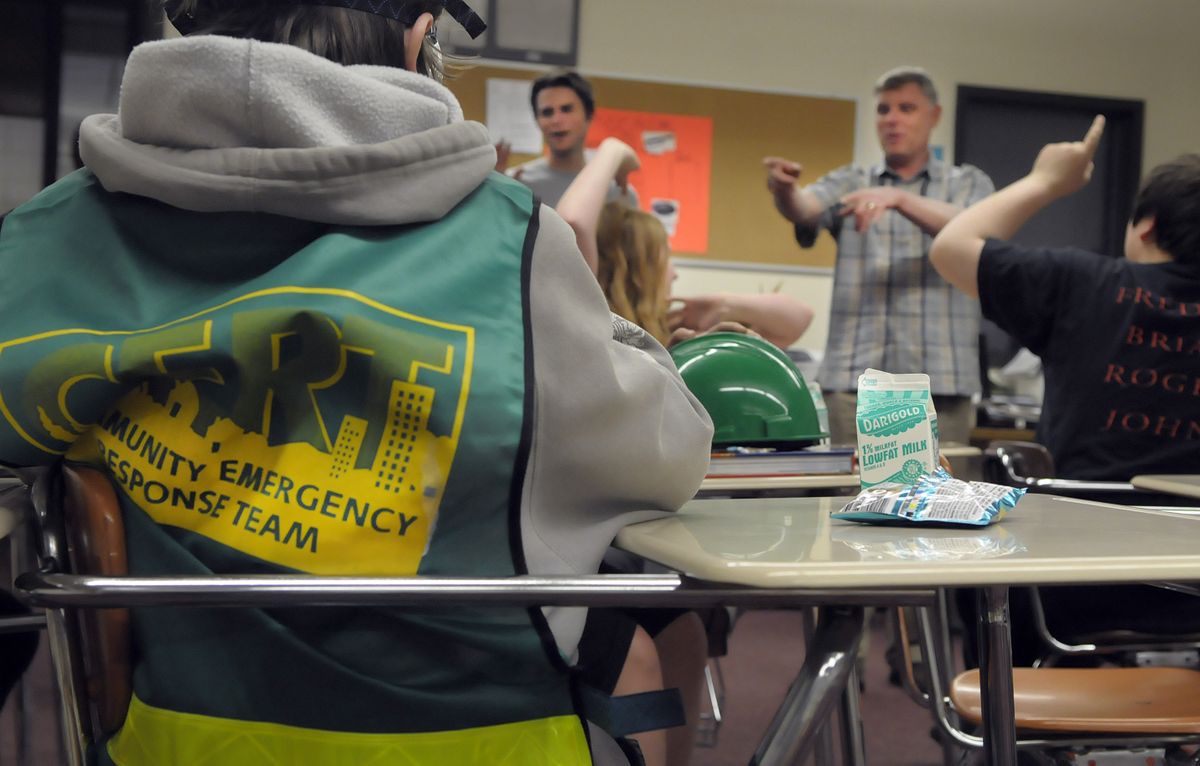This course’s test will be a disaster
AmeriCorps volunteers teach emergency response techniques

The after-school class at Spokane Garry Middle School is a little chaotic: Bobby is dead, Molly has a broken leg and Katie has gone temporarily insane.
Of course nobody is really injured, but the students do an awesome job moaning and carrying on.
This is the last meeting of the Disaster Preparedness Class, a course taught by AmeriCorps volunteers, and the students are eager to demonstrate what they’ve learned during the seven sessions.
“We know how to turn off the gas and electricity now,” said Katie Prior, 12. “And we know that you can’t turn it back on by yourself.”
When asked about natural disasters that could hit the Spokane area, the students quickly reach a consensus on flooding, earthquakes, blizzards and ice storms. And wildfires, of course.
Nate Miller, 14, explains how to use a fire extinguisher if a smaller fire should break out at home.
“You should always aim the extinguisher at the bottom of the fire, where the flames start,” he said.
Among many other things, the students also learned to perform triage in an emergency situation by dividing casualties into four categories: black, you’re dead; yellow, you need severe care; green, you have minor injuries; and red, you are unconscious, bleeding or both.
“It’s a way to know who needs the most help,” said Anthony Thomas, 13, adding that they’ve also learned how to get safely out of their own homes if there’s a fire or an earthquake.
The pretend injuries were needed for an exercise on how to search a dark room for potential victims.
“This may look like it’s all just fun and games,” said Bill Skaer, a Ready Corps VISTA specialist with Spokane Public Schools. “But they actually learn how to search a room systematically, making sure everyone gets out.”
Another favorite exercise is “cribbing,” where students practice lifting a heavy object off a person, using levers to lift the item – in this case a table placed on Prior’s belly – while simultaneously supporting it by stacking wooden blocks.
The students carefully build up supports of wooden blocks, slowly lifting the table off Prior’s legs – until it suddenly slips.
“Sorry,” said Thomas, “if this was real, your legs would now be gone.”
Everyone laughs and starts over again.
Skaer explained that ReadyCorps is part of the Washington Service Corps, which enrolls about 700 AmeriCorps volunteers across the state.
“My program is just a small part of the big pie that’s AmeriCorps,” Skaer said. “My members work specifically with after-school programs for middle-school kids.”
In the CERT – Community Emergency Response Team – club, students learn basic disaster preparedness, fire safety, first aid and how to make disaster kits that work locally, Skaer said.
“AmeriCorps volunteers get paid at the most $950 a month and you can be a member for three years,” Skaer said. “After two years, you can get an education award of about $4,000. Volunteers can use that to go back to school or to pay study loans.” Most stay for two years, Skaer said, but some stay for three.
“Essentially you give up a year of your life by volunteering for very limited pay,” Skaer said. “It’s a pretty exceptional way to help out your community.”
President Obama recently signed the Serve America Act into law.
The act, according to AmeriCorps’ Web site, will expand national service programs under the Corporation for National and Community Service, which oversees 75,000 AmeriCorps members and more than 3.3 million other community volunteers. AmeriCorps received 17,038 online applications in March – that’s nearly triple the number of applications last year, the agency reports.
Skaer said that more people are interested in volunteering for education credit when the economy is strained – which also leads to an increased demand for volunteers from nonprofit groups that serve the needy.
“AmeriCorps volunteers work with many, many social services agencies, like Spokane Neighborhood Action Programs here in Spokane,” Skaer said.
The students at Spokane Garry Middle School agreed it was a great class.
“And we tell our family about the stuff we learn,” said Bobby Nguyen, 12.
So, do any of them dream of careers as EMTs or firefighters?
Molly Maass, 15, said she’d like to become a paramedic because “it would be cool to be able to help people.”
Nguyen had a different thought: “I want to become a surgeon and work at the hospital.”